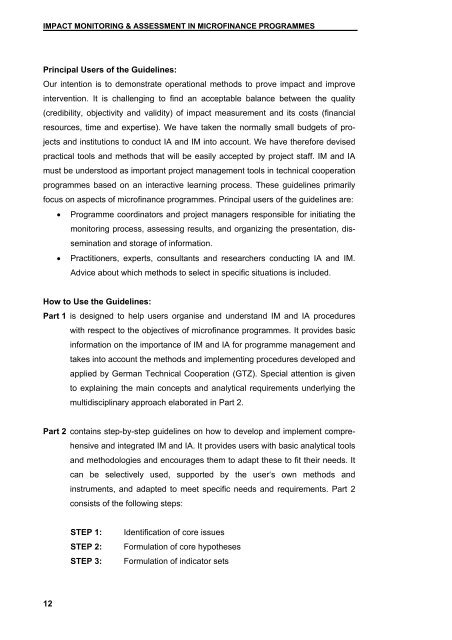Guidelines for Impact Monitoring & Assessment in Microfinance ...
Guidelines for Impact Monitoring & Assessment in Microfinance ...
Guidelines for Impact Monitoring & Assessment in Microfinance ...
Create successful ePaper yourself
Turn your PDF publications into a flip-book with our unique Google optimized e-Paper software.
IMPACT MONITORING & ASSESSMENT IN MICROFINANCE PROGRAMMES<br />
Pr<strong>in</strong>cipal Users of the <strong>Guidel<strong>in</strong>es</strong>:<br />
Our <strong>in</strong>tention is to demonstrate operational methods to prove impact and improve<br />
<strong>in</strong>tervention. It is challeng<strong>in</strong>g to f<strong>in</strong>d an acceptable balance between the quality<br />
(credibility, objectivity and validity) of impact measurement and its costs (f<strong>in</strong>ancial<br />
resources, time and expertise). We have taken the normally small budgets of projects<br />
and <strong>in</strong>stitutions to conduct IA and IM <strong>in</strong>to account. We have there<strong>for</strong>e devised<br />
practical tools and methods that will be easily accepted by project staff. IM and IA<br />
must be understood as important project management tools <strong>in</strong> technical cooperation<br />
programmes based on an <strong>in</strong>teractive learn<strong>in</strong>g process. These guidel<strong>in</strong>es primarily<br />
focus on aspects of microf<strong>in</strong>ance programmes. Pr<strong>in</strong>cipal users of the guidel<strong>in</strong>es are:<br />
12<br />
• Programme coord<strong>in</strong>ators and project managers responsible <strong>for</strong> <strong>in</strong>itiat<strong>in</strong>g the<br />
monitor<strong>in</strong>g process, assess<strong>in</strong>g results, and organiz<strong>in</strong>g the presentation, dissem<strong>in</strong>ation<br />
and storage of <strong>in</strong><strong>for</strong>mation.<br />
• Practitioners, experts, consultants and researchers conduct<strong>in</strong>g IA and IM.<br />
Advice about which methods to select <strong>in</strong> specific situations is <strong>in</strong>cluded.<br />
How to Use the <strong>Guidel<strong>in</strong>es</strong>:<br />
Part 1 is designed to help users organise and understand IM and IA procedures<br />
with respect to the objectives of microf<strong>in</strong>ance programmes. It provides basic<br />
<strong>in</strong><strong>for</strong>mation on the importance of IM and IA <strong>for</strong> programme management and<br />
takes <strong>in</strong>to account the methods and implement<strong>in</strong>g procedures developed and<br />
applied by German Technical Cooperation (GTZ). Special attention is given<br />
to expla<strong>in</strong><strong>in</strong>g the ma<strong>in</strong> concepts and analytical requirements underly<strong>in</strong>g the<br />
multidiscipl<strong>in</strong>ary approach elaborated <strong>in</strong> Part 2.<br />
Part 2 conta<strong>in</strong>s step-by-step guidel<strong>in</strong>es on how to develop and implement comprehensive<br />
and <strong>in</strong>tegrated IM and IA. It provides users with basic analytical tools<br />
and methodologies and encourages them to adapt these to fit their needs. It<br />
can be selectively used, supported by the user‘s own methods and<br />
<strong>in</strong>struments, and adapted to meet specific needs and requirements. Part 2<br />
consists of the follow<strong>in</strong>g steps:<br />
STEP 1: Identification of core issues<br />
STEP 2: Formulation of core hypotheses<br />
STEP 3: Formulation of <strong>in</strong>dicator sets

















![CynefinFramework final [Read-Only]](https://img.yumpu.com/19017304/1/190x135/cynefinframework-final-read-only.jpg?quality=85)